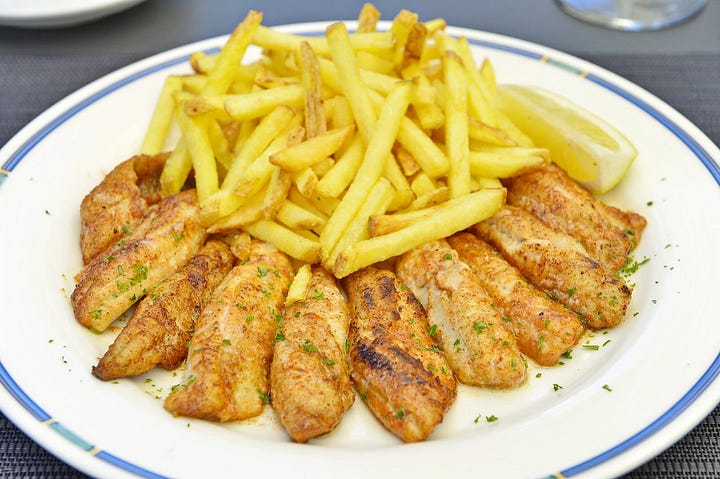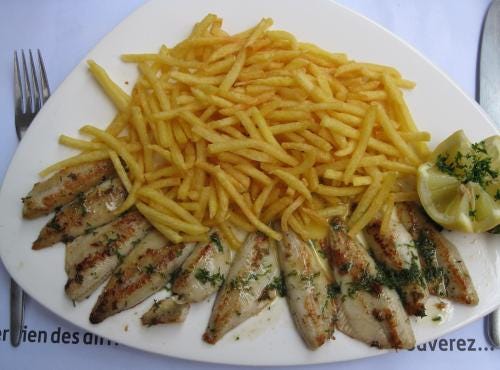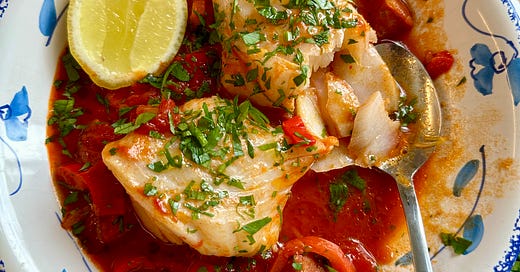Fish, I think, can be an intimidating thing for people to cook. Of course, this depends on the people doing the cooking (I imagine Portuguese children can cook fish by the time they can walk) but here in the U.K we are an island of people who do not eat fish. Not never, not on principle, but just not really. Ironic, given that our national dish is supposedly one comprised of two elements and one of those is fish.
Many years ago I remember my sous chef at a restaurant in Paris (who was Portuguese and could fillet sardines with just his finger) being surprised when I told him I didn’t know how to do some kind of fish preparation for a dish we had on the menu. “You don’t eat this in England?” he asked. I can’t remember what ‘this’ was but I told him that no, we did not. “But why, you are living by the sea, no?” Well yes, but… we don’t really eat that, I explained. He was baffled. I could see that to him this was the equivalent of living in an orchard and not eating apples.
I’m not really sure why we don’t eat seafood in a big way in the UK, especially when we have it readily available and of such high quality, but we don’t. As a consequence, I think many of us here have much less experience cooking fish than meat and therefore think it’s more difficult. It’s not. I didn’t eat or cook much seafood growing up except for when we’d go to Italy or France and to visit my grandparents. In summer, my first priority after passing passport control was always a plate of ‘fillets de perches’, little white fish from Lac Léman on the Swiss/ French border which are floured, fried until golden, served with sauce meunière and most importantly a mountain of golden, salty fries (I expect cooked in beef fat).




A combination of restaurant work and years of quite relentlessly travelling around the Mediterranean has broadened my oceanic horizons and I now consider myself an expert on eating bounty from the sea, and at least competent at cooking it. Today’s recipe is a pretty foolproof way to do it right. Do it right when we’re talking about skinless/boneless white fish fillets (as we’re using here) simply means not overcooking it.
Here in the U.K we are an island of people who do not eat fish.
If you’ve ever made shakshuka then you’ve essentially made this dish, the only real difference is that we’re poaching fish in the sauce instead of eggs. The process is simple, it starts by frying onions, peppers and chorizo and then layering in more flavours like white wine, harissa and chicken stock before adding tomatoes to make a rich and spicy sauce. Once that sauce has cooked a little, you simply add the fish directly into it and let it poach for a few minutes until gently cooked through. A piece of crusty bread alongside is almost non-negotiable.
You’ll see that I ask you to salt your fish and leave it out for 20 minutes or so before cooking. This does two things; it means that the fish isn’t stone cold in the centre when you start cooking it, which will result in an overcooked outside by the time the centre is done. It also means that the salt has a chance to season the fish all the way through, not just on the outside. As the salt goes on this journey through the fillets via osmosis it will also pull excess moisture from the fish and cause it to firm up little. This is a good thing and makes for easier cooking. Unlike chicken, which you can salt a day before, don’t be tempted to salt the fish more than 20 minutes before cooking because it can become tough.
The Recipe
Ingredients:
2 shallots or a small onion
2 long red peppers or 1 bell pepper
100g chorizo
2 cloves garlic
A stick of rosemary
1 tbsp harissa, or a pinch of chilli
200ml white wine
200ml chicken stock
1 tin tomatoes
4 skinless boneless cod loins (or other firm white fish like hake or bass)
Small handful of parsley
1 Lemon
Method:
Season your fish on both sides with salt and leave out for 20 minutes to come to room temperature.
Finely dice the shallots, core and chop the pepper into roughly 1x2cm strips and cube up the chorizo, not too small (see this video).
Add everything to a pan with a touch of olive oil and a pinch of salt and then place over a medium heat (don’t add much oil as the chorizo will release its own as it renders).
After 4 or 5 minutes, once the onions and peppers are soft, finely slice and add the garlic, a stick of rosemary and a tbsp (or to your taste) of harissa/ chilli and cook for another 2 mins.
Pour in the wine and let it bubble, scraping the bottom of the pan as you do, until the wine has almost evaporated. Pour in the stock, reduce by half and then add the tomatoes and a pinch of salt.
Let the sauce cook for 6 or 7 minutes until it has thickened slightly but not as much as a tomato sauce for pasts; it still needs to be loose enough that you can 3/4 submerge the fish fillets in it.
The salt will have pulled some moisture from the fish so pat them dry and nestle them into the sauce which should be gently bubbling. Leave to cook for 5 or 6 minutes, depending on the size, at which point they should yield to a push from a fork and separate into moist flakes.
You can always carefully flip them for a minute to cook the exposed top. If you’re taking the dish to the table in the pan, remember that the fish will keep cooking from the residual heat.
Plate up and finish with chopped parsley, a big squeeze of lemon and drizzle of olive oil (I think all of my recipes finish with that sentence).





Made this w stock - gorgeous
Going to make this tonight! Can I replace the wine with more stock? Or water?